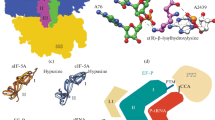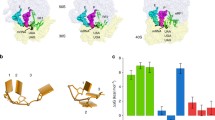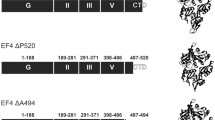Abstract
Translation termination in eukaryotes is governed by two proteins belonging to class 1 (eRF1) and class 2 (eRF3) polypeptide release factors. eRF3 catalyzes hydrolysis of GTP to yield GDP and Pi in the ribosome in the absence of mRNA, tRNA, aminoacyl-tRNA, and peptidyl-tRNA and requires eRF1 for this activity. It is known that eRF1 and eRF3 interact with each other via their C-terminal regions both in vitro and in vivo. eRF1 consists of three domains—N, M, and C. In this study we examined the influence of the individual domains of the human eRF1 on induction of the human eRF3 GTPase activity in the ribosome in vitro. It was shown that none of the N, M, C, and NM domains induces the eRF3 GTPase activity in the presence of ribosomes. The MC domain does induce the eRF3 GTPase activity, but four times less efficiently than full-length eRF1. Therefore, we assumed that the MC domain (and very likely the M domain) binds to the ribosome in the presence of eRF3. Based on these data and taking into account the data available in the literature, a conclusion was drawn that the N domain of eRF1 is not essential for eRF1-dependent induction of the eRF3 GTPase activity. A working hypothesis is formulated that the eRF3 GTPase activity in the ribosome during translation termination is associated with the intermolecular interactions of GTP/GDP, the GTPase center of the large (60S) subunit, the MC domain of eRF1, and the C-terminal region and GTP-binding motifs of eRF3 but without participation of the N-terminal region of eRF1.
Similar content being viewed by others
References
Kisselev L.L., Ehrenberg M., Frolova L.Yu. 2003. Termination of translation: interplay of mRNA, rRNAs and release factors? EMBO J. 2, 175–182.
Nakamura Y., Ito K. 2003. Making sense of mimic in translation termination. Trends Biochem. Sci. 28, 99–105.
Poole E.S., Askarian-Amiri M.E., Major L.L., McCaughan K.K., Scarlett D.J., Wilson D.N., Tate W.P. 2003. Molecular mimicry in the decoding of translational stop signals. Prog. Nucleic Acids Res. Mol. Biol. 74, 83–121.
Song H., Mugnier P., Webb H.M., Evans D.R., Tuite M.F., Hemmings B.A., Barford D. 2000. The crystal structure of human eukaryotic release factors eRF1: Mechanism of stop codon recognition and peptidyl-tRNA hydrolysis. Cell. 100, 311–321.
Bertram G., Bell H.A., Ritchie D.W., Fullerton G., Stansfield I. 2000. Terminating eukaryote translation: Domain 1 of release factor eRF1 functions in stop codon recognition. RNA. 6, 1236–1247.
Frolova L., Seit-Nebi A., Kisselev L. 2002. Highly conserved NIKS tetrapeptide is functionally essential in eukaryotic translation termination factor eRF1. RNA. 8, 129–136.
Seit-Nebi A., Frolova L., Kisselev L. 2002. Conversion of omnipotent translation termination factor eRF1 into ciliate-like UGA-only unipotent eRF1. EMBO Rep. 3, 881–886.
Ito K., Frolova L., Seit-Nebi A., Karamyshev A., Kisselev L., Nakamura Y. 2002. Omnipotent decoding potential resides in eukaryotic translation termination factor eRF1 of variant-code organisms and is modulated by the interactions of amino acid sequences within the domain 1. Proc. Natl. Acad. Sci. USA. 99, 8494–8499.
Frolova L.Y., Tsivkovskii R.Y., Sivolobova G.F., Oparina N.Y., Serpinsky O.I., Blinov V.M., Tatkov S.I., Kisselev L.L. 1999. Mutations in the highly conserved GGQ motif of class 1 polypeptide release factors abolish ability of human eRF1 to trigger peptidyl-tRNA hydrolysis. RNA. 5, 1014–1020.
Seit-Nebi A., Frolova L., Justesen J., Kisselev L. 2001. Class-1 translation termination factors: Invariant GGQ minidomain is essential for release activity and ribosome binding but not for stop codon recognition. Nucleic Acids Res. 29, 3982–3987.
Zavialov A.V., Mora L., Buckingham R.H., Ehrenberg M. 2002. Release of peptide promoted by the GGQ-motif of class-1 release factors regulates the GTPase activity of RF3. Mol. Cell. 10, 789–798.
Mora L., Heurgue-Hamard V., Champ S., Ehrenberg M., Kisselev L.L., Buckingham R.H. 2003. The essential role of the invariant GGQ motif in the function and the stability in vivo of bacterial release factors RF1 and RF2. Mol. Microbiol. 1, 267–275.
Ito K., Ebihara K., Nakamura Y. 1998. The stretch of C-terminal acidic amino acids of translational release factor eRF1 is primary binding site for eRF3 of fission yeast. RNA. 4, 958–972.
Merkulova T.I., Frolova L.Yu., Lazar M., Camonis J., Kisselev L. 1999. C-terminal domains of human translation termination factors eRF1 and eRF3 mediate their in vivo interaction. FEBS Lett. 443, 41–47.
Ebihara K., Nakamura Y. 1999. C-terminal interaction of translational release factors eRF1 and eRF3 of fission yeast: G-domain uncoupled binding and the role of conserved amino acids. RNA. 5, 739–750.
Eurwilaichitr L., Graves F.M., Stansfield I., Tuite M.F. 1999. The C-terminus of eRF1 defines a functionally important domain for translation termination in Saccharomyces cerevisiae. Mol. Microbiol. 32, 485–496.
Zhouravleva G., Frolova L., Le Goff X., Le Guellec R., Inge-Vechtomov S., Kisselev L., Philippe M. 1995. Termination of translation in eukaryotes is governed by two interacting polypeptide chain release factors, eRF1 and eRF3. EMBO J. 14, 4065–4072.
Frolova L., Le Goff X., Zhouravleva G., Davydova E., Philippe M., Kisselev L. 1996. Eukaryotic polypeptide chain release factor eRF3 is an eRF1-and ribosome-dependent guanosine triphosphatase. RNA. 2, 334–341.
Stansfield I., Jones K.M., Kushnirov V.V., Dagkesamanskaya A.R., Poznyakovski A.I., Paushkin S.V., Nierras C.R., Cox B.S., Ter-Avanesyan M.D., Tuite M.F. 1995. The products of the SUP45 (eRF1) and SUP35 genes interact to mediate translation termination in Saccharomyces cerevisiae. EMBO J. 14, 4365–4373.
Buckingham R., Grentzmann G., Kisselev L. 1997. Polypeptide chain release factors. Mol. Microbiol. 24, 449–456.
Frolova L.Y., Merkulova T.I., Kisselev L.L. 2000. Translation termination in eukaryotes: Polypeptide release factor eRF1 is composed of functionally and structurally distinct domains. RNA. 6, 381–390.
Kabcenell A.K., Goud B., Northup J.K., Novick P.J. 1990 Binding and hydrolysis of guanine nucleotides by Sec4p, a yeast protein involved in the regulation of vesicular traffic. J. Biol. Chem. 265, 9366–9372.
Frolova L., Simonsen J., Merkulova T., Litvinov D., Martensen P., Rechinsky V., Camonis J., Kisselev L., Justesen J. 1998. Functional expression of eukaryotic polypeptide chain release factors 1 and 3 by means of baculovirus/insect cells and complex formation between the factors. Eur. J. Biochem. 256, 36–44.
Kisselev L.L., Oparina N.Yu., Frolova L.Yu. 2000. Class-1 polypeptide chain release factors are structurally and functionally similar to suppressor tRNAs and comprise different structural-functional families of prokaryotic/mitochondrial and eukaryotic/archaebacterial factors. Mol. Biol. 34, 427–441.
Yusupov M., Yusupova G.Z., Baucom A., Lieberman K., Earnest T.N., Cate J.H.D., Noller H.F. 2001. Crystal structure of the ribosome at 5.5 Å resolution. Science. 292, 883–896.
Ramakrishnan V. 2002. Ribosome structure and mechanism of translation. Cell. 108, 557–572.
Graifer D., Molotkov M., Styazhkina V., Demeshkina N., Bulygin K., Eremina A., Ivanov A., Laletina E., Ven’yaminova A., Karpova G. 2004. Variable and conserved elements of human ribosomes surrounding the mRNA at the decoding and upstream sites. Nucleic Acids Res. 32, 3282–3293.
Bulygin K., Chavatte L., Frolova L., Karpova G., Favre A. 2005. The first position of a codon placed in the A site of the human 80S ribosome contacts nucleotide C1696 of the 18S rRNA as well as proteins S2, S3, S3a, S30 and S15. Biochemistry. 44, 2153–2162.
Chavatte L., Frolova L., Laugaa P., Kisselev L., Favre A. 2003. Stop codons and UGG promote efficient binding of the human polypeptide release factor eRF1 to the eukaryotic ribosomal A site. J. Mol. Biol. 331, 745–758.
Author information
Authors and Affiliations
Additional information
Original Russian Text © V.I. Dubovaya, P.M. Kolosov, E.Z. Alkalaeva, L.Yu. Frolova, L.L. Kisselev, 2006, published in Molekulyarnaya Biologiya, 2006, Vol. 40, No. 2, pp. 310–316.
Rights and permissions
About this article
Cite this article
Dubovaya, V.I., Kolosov, P.M., Alkalaeva, E.Z. et al. Influence of individual domains of the translation termination factor eRF1 on induction of the GTPase activity of the translation termination factor eRF3. Mol Biol 40, 270–275 (2006). https://doi.org/10.1134/S0026893306020130
Received:
Issue Date:
DOI: https://doi.org/10.1134/S0026893306020130




